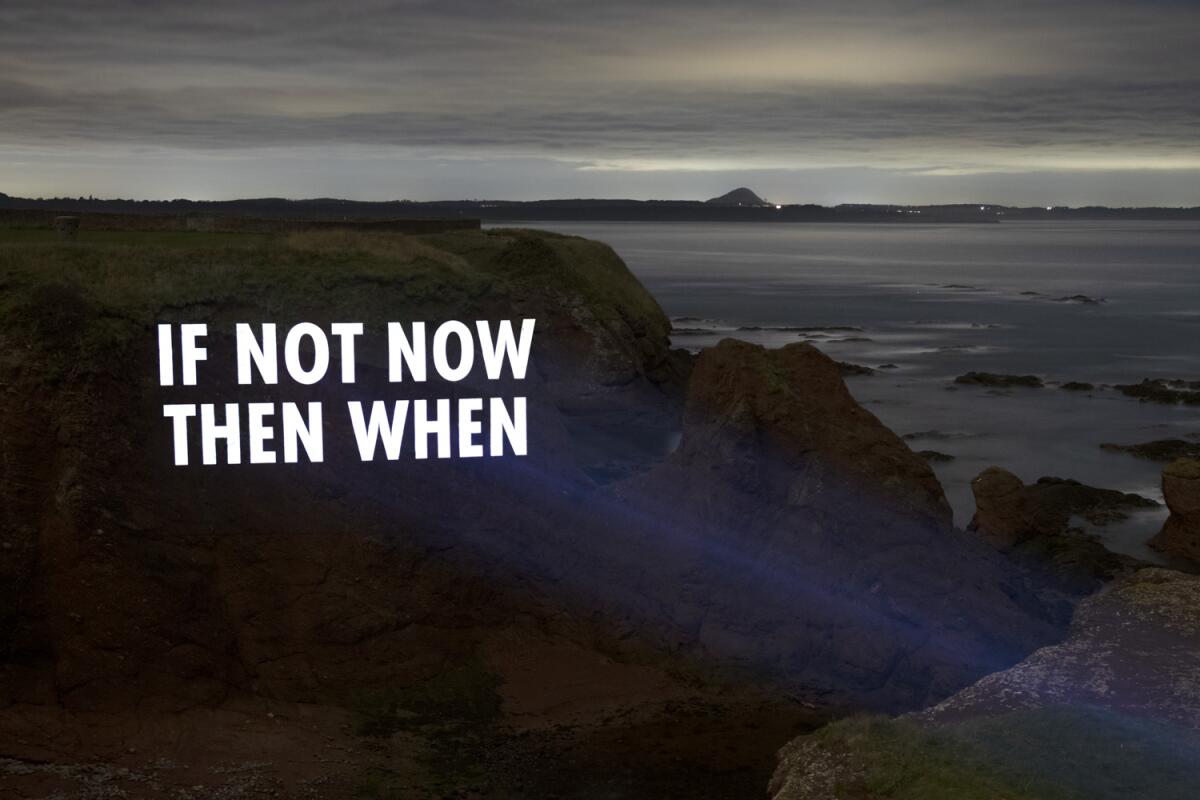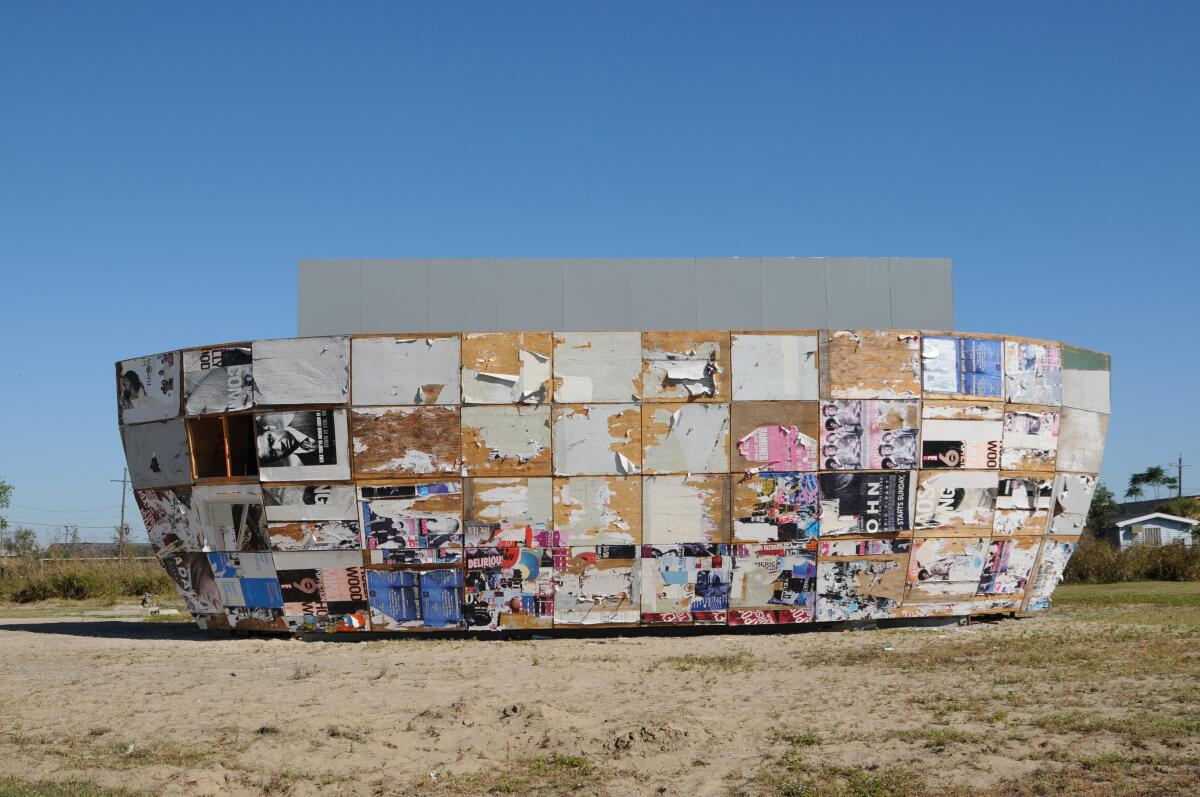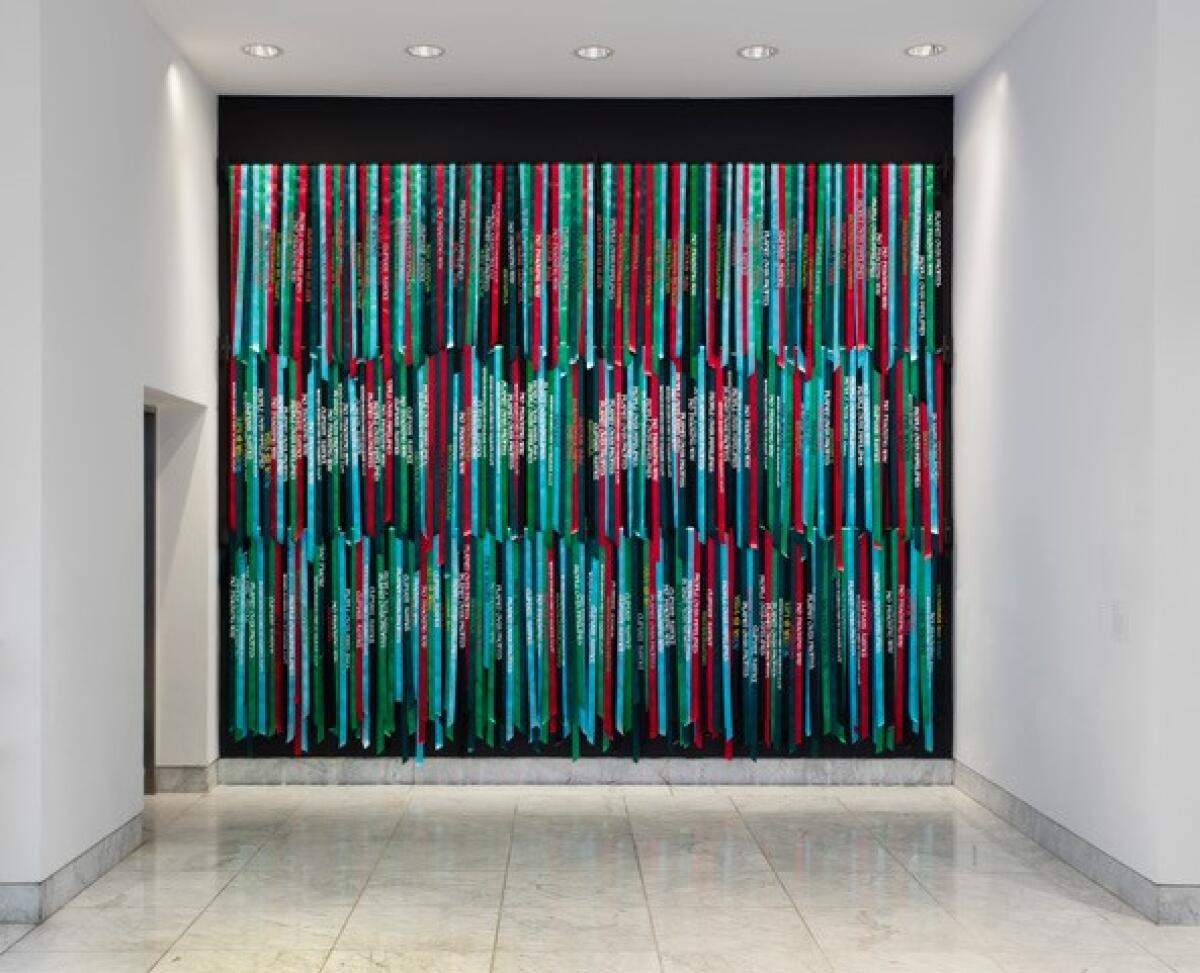‘The time is now’: A debut exhibition of artworks around L.A. speak to climate crisis

- Share via
Next week, leaders from many Western Hemisphere countries will gather in Los Angeles for the ninth Summit of the Americas, a weeklong conference, hosted this year by the Biden administration, on addressing regional issues that include fighting climate change, slowing migration and recovery from the COVID-19 pandemic.
L.A. artists Mark Bradford and Andrea Bowers, along with New York artist Jenny Holzer, are launching a three-part public art exhibition across the city to debut in tandem with the summit, shining a spotlight on the climate crisis facing our planet.
The project is a collaboration with Emerson Collective, a Palo Alto-based organization founded and run by Laurene Powell Jobs, that’s engaged in philanthropy, advocacy and “impact investing towards social change,” says Director of Strategy Integration Jennifer Arceneaux.
“We saw this moment as a tremendous opportunity to raise awareness around climate migration and the climate crisis while we have the world’s leaders gathering in Los Angeles,” Arceneaux says. “We’re really moved by these artists and their ability to instigate and to provoke and to stir, and we’re hoping to engage Angelenos in a conversation.”
The artworks, which go on view starting June 4, include both installations and activations. Bradford is presenting his large-scale, iconic sculpture, “Mithra,” at Los Angeles State Historic Park downtown. Holzer is installing several dozen billboards, light projections and LED signs across the city with messages from climate activists, writers, scholars and people whose lives have been affected by environmental disasters. Bowers will carry out the next iteration of her “Political Ribbons” series, an ongoing site-specific, participatory project that debuted at New York’s Jewish Museum in 2016. A variation of it was shown at the Hammer Museum in 2017, and it has since been activated around the world.

Bradford’s “Mithra” has been shown internationally, but never before in L.A. It’s a massive, 70-foot-long Noah’s Ark-like vessel crafted from recycled, wheat-pasted plywood and steel. A response to Hurricane Katrina, it was created for the 2008 Prospect.1 Biennial New Orleans, where itwas shown outdoors, in the city’s Lower 9th Ward. The installation at Los Angeles State Historic Park — where the piece will sit on a vast ocean of grass as if washed ashore onto an urban oasis — is also the first time, since its inaugural showing, that it’s being presented outdoors.
“To me it’s a symbol of a shared responsibility to protect the most vulnerable against threats of climate change,” Bradford says of the work. “It’s like this hasty, poor construction of a ship built to escape a fast approaching calamity, like rising sea water. It’s a call to reduce and reverse our impact on the planet by any means necessary, and with whatever resources are available. The damage has already been done.”
Los Angeles State Historic Park is a well-considered location, Bradford says. The park has a history concerning environmental justice. The communities nearby, many of which are immigrant enclaves, fought to turn the land — a former rail yard turned “brown field” that sat vacant for decades — into green space for public use instead of being developed as an industrial center.
“It’s about spaces that can be used by many people and that have a history of belonging to people, and as these spaces close in more and more and more we lose more and more green space,” Bradford says. “Which again has to do with climate and weather and spaces and people — how it impacts people.”
Holzer will show an updated version of her “Hurt Earth,” which was originally presented at the 2021 United Nations Climate Change Conference in Glasgow, Scotland. Her billboards, light projections and LED signs will appear in downtown L.A., the Miracle Mile and Mid-Wilshire areas, Hollywood and West Hollywood as well as in Griffith Park, along the Santa Monica Bluffs and in Point Mugu State Park.
The messages will take the form of both planned activations, targeting areas where large crowds will be gathered, as well as “guerilla-style pop-up installations” on the sides of buildings, like a car dealership, or in nature, on a park hillside — scenic locations in which the messages will be documented with drones and shared later, via livestreaming or on social media. Her static billboards are already up and visible from the Santa Monica Freeway heading through downtown. And there will be a presentation of messages both before and after this Saturday’s screening of “American Psycho” at Hollywood Forever Cemetery.
Rather than “opining” about climate crisis, Holzer prefers to let her project do the talking: “The time is now, the time is urgent,” one message reads. “We have the fundamental right to a livable future,” reads another.
“And there are some tougher ones that will make you weep,” Holzer says. “People do beautifully speaking for themselves and about their own concerns. I wouldn’t presume. I simply collect and represent.”

Bowers and a group of volunteers will, throughout the week, distribute about 5,000, brightly colored silk-screened ribbons, for free, to participants at public protests and other summit-related events held around the city. It’s the artist’s largest non-institutional ribbon activation to date. The colors are significant, she says, with blue and green evoking aspects of nature. “And red is a very famous political color going back to the 1800s,” she says, “and I always think of pink as radical femme. I think there’s a whole femme aspect to this because the suffragettes made, and wore, so many political ribbons. Those were replaced by buttons, but ribbons are so much more exciting and fun.”
Each of Bowers’ ribbons carries a climate emergency message, such as “System change not climate change;” “Forests are the lungs of the earth” and “Women and the earth have to tolerate a lot.” She encourages recipients to share the ribbons at future events or on social media.
“That’s the most exciting part of it. This project can have a large presence,” says Bowers, who has a major retrospective opening at the Hammer Museum later this month. “The climate crisis is a huge, recurring problem. There is no time left. We’re destroying our planet and are heading towards our own extinction. If another world is even still possible, we have to change how we live on this planet.”
Arceneaux says that while raising awareness is key to the project, so is sparking calls to action.
“We believe that hyperlocalized action can be incredibly profound in this moment and we also know that national action is critical,” she says. “It could be protesting, it’s about voting, it’s also about encouraging our own civic action and ownership around ensuring we’re collectively invested in the issue.”
The three artists’ very different artistic approaches to expressing urgency around climate crisis was exciting to Emerson Collective, as was their shared unwavering commitment.
“And there’s also a sense of optimism that binds the work,” she adds. “Can the work offer hope and inspiration?”
More to Read
The biggest entertainment stories
Get our big stories about Hollywood, film, television, music, arts, culture and more right in your inbox as soon as they publish.
You may occasionally receive promotional content from the Los Angeles Times.











